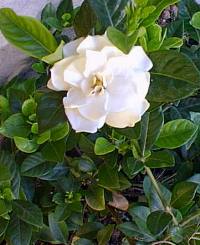Sunset®: 7-9, 11-16, 18-28, 31
USDA: 9b-10
Frost Tolerance: Hardy to 20° F (-7°C)
Sun Exposure: Light shade in Phoenix
Origin: China
Growth Habits: Evergreen shrub to 6 feet; glossy dark green leaves,3 to 6 inches long (7-15 cm)
Flowers: White flowers
Watering Needs: Regular water
Propagation: Softwood cuttings with heels in February. Roots at 80° F (27 ° C)
Propagation: Cutting or occasionally grafting/budding
- by softwood stem tip cuttings, in early summer. Use intermittent mist. Root in 4-8 weeks.
- by grafts.
Gardenia jasminoides or Common Gardenia or Cape Jasmine is an evergreen shrub, which grows to a height of 2 to 6 feet, depending on the variety. Spread is about the same. The foliage of well-fed shrubs is glossy, dark-green, 2 to 4 inches long and half as wide. Depending on the cultivar, the flowers can be either single or double and up to 4 inches in diameter. They are waxy, white and very fragrant.
Blooming Habits:
The gardenia flowers are highly fragrant. They open over a long period of time, from May through July and make great cut flowers.
source USDA/Clemson University
Culture:
Gardenias require considerable maintenance. Fall or spring is the best time for planting. Plant in light to moderate shade, preferably with minimum competition from tree roots. Gardenias resent root disturbance. They also grow well in pots.
Gardenias prefer acid, moist, well-drained soils. In Phoenix soils, chlorosis generally is a problem. Use fertilizer for acid loving plants, and use iron compounds. Add plenty of organic matter, such as compost or ground bark, to as large an area as possible. Mulch plants instead of cultivating. A good time to feed gardenias is mid-March, using an acid plant food, fish emulsion or blood meal. Feed the shrubs again in late June to encourage extra flowers on everbloomers or faster growth of young shrubs. Do not fertilize gardenias in the fall. Doing so will stimulate tender growth, which may be killed if the temperature in winter drops below 15 degrees. Gardenias are cold-sensitive and during severe winters can be killed to the ground in the Upstate. Often they regenerate in spring.
Prune shrubs after they have finished flowering to remove straggly branches and faded flowers. Water gardenias regularly. Drip-irrigating the shrubs will keep water off the foliage and blossoms and prevents leaf spots. Regular watering is necessary after blooming also to keep the plants in good condition and able to withstand winter weather.
Several insects and diseases are likely to show up on your gardenia. When sooty mold coats gardenia leaves in summer, it is usually due to an infestation of whiteflies. These sucking insects look like bits of cotton. While eating, they excrete excess moisture in the form of honeydew and this, in turn, supports the growth of a black fungus. Similar in habit are small gray aphids, which cling to leaf undersides. In sandy soil, nematodes can cause gardenias to be stunted or even die. Nematodes are microscopic worms, which live in the soil and feed on plant roots. Root rots caused by several different fungi can also be a problem, especially in poorly drained soils.
Another problem encountered is "bud drop." Flower buds abort and drop off just before they open. Common causes include low humidity, overwatering, underwatering, insufficient light and high temperatures (night temperatures between 50 and 55 ° F are necessary for the formation of flower buds).
Desert-Tropicals is dedicated to provide gardening advice, gardening ideas, and information about flower of all kind for landscape and collections.We try to check carefully the identification of the plants on the illustrations as well as the other information from the page, but occasionally errors do occur. if you notice anything that needs to be changed please contact us.Thanks.
© 1998-2020 Philippe Faucon, All Rights Reserved.
